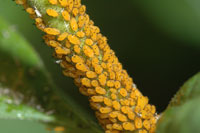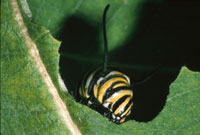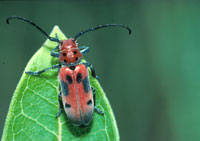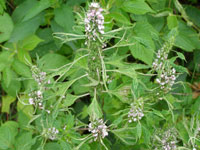Extension > Garden > Diagnose a problem > What's wrong with my plant? > Annuals and Perennials > Milkweed
Annuals and Perennials > Milkweed
1 of 5
Aphids
- Occurs during summer
- Feed in large groups on leaves and stems
- No other injury visible
- Tiny, yellow to orange aphids with black legs
2 of 5
Monarch caterpillar
- Occurs during summer
- Chews holes along the edge of leaves
- White with yellow and black markings, up to 2 inches long
3 of 5
Four-eyed milkweed beetles
- Occurs during mid to late summer
- Chew holes in leaves
- Red with black spots and long antennae, 1/2 inch long
4 of 5
Herbicide Damage
Phenoxy herbicide ex. 2,4D
- Leaves are twisted, cupped, or distorted
- Leaves may appear thick and leathery
- Veins in leaves are thick and close together
- Side of the plant closest to the herbicide application is most severely affected
- In severe cases the entire plant may be affected
5 of 5
Hail
- Ragged holes in foliage
- Appears suddenly, after sever weather
- Affects very local area only, sometimes individual plants show damage
- Plants outgrow damage, leaves produced after hail event are undamaged











